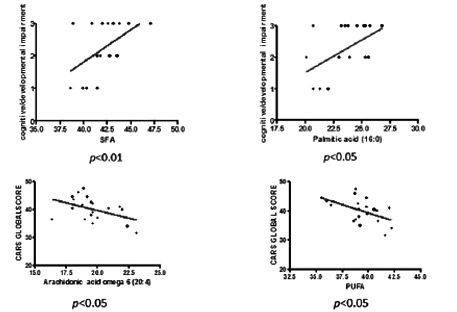
Autism, essential fats and lipidomic membrane analysis

Topic 1: WHICH FATS ARE ESSENTIAL?
Fats synthesized as saturated, monounsaturated and polyunsaturated fats are all necessary in different proportions between them for the genesis and the development of the human cell. Some of them, called polyunsaturated fatty acids, are essential and are also known to the non-expert public as omega-6 and omega-3, because they must be taken through food and cannot be prepared independently by the cell itself. For the cells genesis, since fetal growth during the 9 months of pregnancy, an excellent availability of these fats must be ensured, especially of those that cannot be prepared independently. Science has clarified that if the diversity of fats is not ensured, dysfunctions and problems occur at all tissues’ level, of processes such as recognition and immunity, of the metabolism and functioning of all systems, and this is a crucial topic for well-being. and the subsequent growth of the newborn (J. Health Popul. Nutr. 2015, 33:14).
Fats are a well-known topic and their need is shared by all international agencies dealing with health and nutrition (World Health Organization, European Food Safety Authority). The intake of omega-6 and omega-3 (250 mg / day) must not be lacking for pregnant women or for infants and children and, remember, it must always be present also for adults.
Topic 2: THE IMPORTANCE OF FATS FOR CELLS OF THE NERVOUS SYSTEM
Fats form a necessary part of the cell which is the CELL MEMBRANE. No cell can exist without a membrane which is formed by a precise mixture of saturated, monounsaturated and polyunsaturated fatty acids for each tissue (Nat. Rev Mol. Cell Biol. 2018, 19, 281-296). Furthermore, precisely for the cell of the nervous system, which also allows to give the characteristic elongated shape and with many ends of the neuron, the presence of DHA (omega-3) and arachidonic acid (ARA, omega-6) must be guaranteed in equal proportion (see Figure).
This fat composition allows the insertion of other components, such as proteins, to allow the passage of ions (for example sodium and potassium). In conditions of normal composition, the brain cell is flexible and can be efficiently connected to other cells of the nervous tissue, to form a “latticework” that “turns on” and “turns off” allowing the passage of signals. Furthermore, for the cell of the nervous system, inflammation is a process that must be constantly under control, and this is achieved precisely through an adequate balance of omega-3 and omega-6 fats. A deficiency or excess condition of these two types of fats can cause malfunction of the nervous tissue, affecting learning and behavior processes for the worse, as well as aggravate a pathological condition (Int. J. Biochem. Cel Biol. 2017, 84:40 -45).
Topic 3: EVIDENCE OF THE ROLE OF OMEGA-3 IN AUTISM
Autism is a complex health condition that cannot be attributed to a single, prevalent cause. In addition to some genetic predisposition, environmental causes and various types of toxicity have been identified as factors concurrent to the occurrence of this syndrome (Dialogue Clin. Neurosci. 2012, 14: 281-292). The “puzzle” of contributions involved in this complex health condition requires a multidisciplinary approach by the doctor who evaluates it. Our research team at the CNR of Bologna collaborated with the children’s neuropsychiatric unit at the Maggiore Hospital of Bologna to determine the composition of the cell membrane fats in children suffering from autism spectrum disorder. We have examined the membrane of the mature red blood cell, which can be related to the condition of the membrane of the nerve cell, and – by means of an analytical, reliable and repeatable because completely automated processing procedure – we have determined the composition of the fats, showing the presence of some fundamental deficits. In two different groups of autistic children compared to healthy children, an omega-3 DHA deficiency (PLoS One. 2013 Jun 19; 8 (6): e66418; Sci. Rep. 2017, 7, 9854) was shown with a threshold of 4% below which the risk of disturbances increases 6 times. In addition, in this research the correlation between saturated fatty acids and cognitive difficulties was also determined, or an increase in behavioral manifestations typical of autism (PLoS One. 2013 Jun 19; 8 (6): e66418).
DHA is both an indispensable element for the formation of the membrane and its flexibility, and is a natural anti-inflammatory in the brain by balancing the presence of arachidonic acid, to reduce the possibility of degeneration of these important and delicate cells. Furthermore, the quantity of SATURATED FATS present in the membrane of neuronal cells must be balanced by that of unsaturated fats, otherwise the functioning of important proteins is inappropriate, as has been demonstrated for the sodium / potassium ATPase pump (PLoS One. 2013 Jun 19; 8 (6): e66418).
The observed imbalances establish a very important molecular information because, especially in the growth stages, as explained in Topic 1, there must be no anomalies in the composition of fats in cell membranes. Therefore, appropriate nutritional measures must be taken to bridge the imbalances and restore the membrane to its normal composition.
What is membrane lipidomic analysis? How can it help in autism?
The cell membrane can be “read” by analyzing its fat composition to understand if there are deficient elements that can cause it to malfunction (Expert Rev. Mol. Diagn. 2012, 12, 767–780; C. Ferreri, C. Chatgilialoglu, Membrane Lipidomics for Personalized Health, J. Wiley & Sons, Chichester, 2015). The method consists of isolating the mature red blood cell (taken from a small blood sample in EDTA as an anticoagulant), and obtaining its membrane with the extraction of fats, subsequently analyzed by gas chromatography (GC) which is the “gold standard” in this sector. The method is completely automated thanks to a robotics developed in the Lipidomics Laboratory of Lipinutragen, and the analysis is distributed under the name of FAT PROFILE®.
The lipidomic membrane analysis is a tool that first of all allows to understand if the subject is in a normal condition, without deficiencies in essential fats. Recall that the DEFICIENCY OF ESSENTIAL FATTY ACIDS (EFA deficiency) is well known in the books of Human Pathology and is linked to various neurological, metabolic, dermatological, immune, cardiovascular symptoms etc.
In addition, membrane lipidomic analysis allows fragile people, such as children already diagnosed for behavioral problems or attention deficit, to highlight and intervene on molecular deficiencies, which can contribute to the malfunction of the cells of the nervous system and their functions. Although the autistic spectrum is a complex pathological condition, not dating back to just one cause, it is important to avoid essential deficiencies in this type of patient who can contribute to the aggravation of already compromised functions. Recalling the importance of DHA as a neuro-anti-inflammatory element, it is highlighted that its absence makes it a fundamental defense of the nervous system. If inflammatory conditions occur without the protection of DHA, the nervous system at an early age would be more subjected to an insult and could not react effectively.
We are also convinced that, by highlighting these molecular deficiencies as soon as possible, for example in the immediately postnatal period, a sort of “molecular prevention” can be implemented by intervening on the body to fill the deficiency and allow the cells to reorganize their activities. This concerns above all those natural and spontaneous processes, such as the formation of cell membranes and the correct positioning of proteins in the membrane itself. These processes take place on the basis of what is present in the molecular kit of the cells. Providing for perfectly balanced kits is the first condition that allows the correct development of the organic tissue.
Considering all that has been said so far, it is very clear that lipidomic analysis is an indispensable tool for assessing normal levels of essential fatty acids and intervening on the highlighted deficits or imbalances, setting up a personalized nutra-strategy. This applies to prevention, before the diagnosis of disorders that could be traced back to a deficiency of essential fats, and also during the treatment of complex problems such as autism spectrum disorders. The clinical observation of the following months from the setting of a lipidomic strategy will tell which and how many improvements have been recorded, also making use of the control with a second lipidomic membrane analysis (after 4-6 months), to verify that essential fats intaked by the subject have reached their site of activity or: the CELL MEMBRANE.
Article by Dr. Carla Ferreri – First ISOF-CNR researcher and founding member Lipinutragen
Photo: 123RF Archivio Fotografico: 98944691 ©Olga Yastremska /123rf.com
- On 31 March 2020





